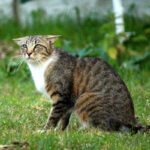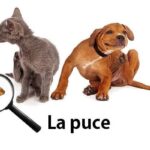The oral health of cats can deteriorate over a long term and the first teeth to show signs of « degeneration » being always those behind, molar and premolar. Only a regular thorough examination, open mouth, can update its different tartar and gingivitis problems in the cat. The teeth of ahead can seem sound but the mouth in reality of tartar and oral problems. « Fortunately », there is the poor characteristic breath, the alarm and the first « visible » index of the triggering of the process of periodontal disease and gingival. These (plate, tartar, gingivitis, consequences and complications) have become the biggest danger to the health of cats who will be victims at the age of 3 for 80% of them. The lack of suitable dental care is the first responsible but wet food, physical problems (supernumerary teeth, deformations), and / or health (uremia, diabetes, local or general immunodeficiency) also influence the appearance of these oral and periodontal diseases. Tartar formation can also be a genetic predisposition in some breeds: Persans and Burdles.
Formation of the plate
The food debris accumulates between and on the teeth, the few 350 species of bacteria peeping the oral cavity feeds, develop and multiply. An invisible film with a bare eye composed of agglutinated bacteria on the surface of the teeth then forms, the biofilm, creating inflammation. The five stages of its development are irreversible unless regular dental hygiene, the process is repeated indefinitely. When the teeth affected by the accumulation of these bacteria take an orange hue, the layers of bacteria have multiplied and then we speak of dental plaque (more than 10 million bacteria per milligram of plate!). In contact with saliva this plaque steams, hardens, descends under the gum. At this stage we are now in the presence of tartar. Tartar is recognized by its color that can vary in shades of yellow, ocher, brown or gray.
Tartar
The amount of bacteria present is now really very important, this concentration of germs in the tartar is the equivalent of that found in the stool. This means the severity of the situation. Gingivitis and bleeding, periodontitis, inflammations of the bottom of the mouth, pillars of the language (caudal stomatites), and the language (glossitis), abscess, caries, the decryation, the falling teeth, all these Very painful disorders for the cat are the direct consequences of tartar accumulated on teeth. Untreated, these infections can degenerate more. The bacteria and microbes can pass into the blood and migrate to organs like the heart and the kidneys. Some serious illnesses are developing: heart failings and renal in elderly animals.
GINGIVITIS
Accumulated under the gum, tartar irritizes and fragile, causing gingivitis. The gingiva is then inflammated, swollen and red, peeled from the tooth, bleeding during the meal, and painful to the point that the cat can refuse any food. This periodontal disease is a reversible inflammation if its cause, the formation of the bacterial plate causing tartar, is supported and eliminated. Since gingivitis being the starting point for more serious and invasive periodontal diseases for the system, we understand the importance of preventing it, at least to treat it without waiting, as soon as it appears. To do this, the veterinarian proceeds to a descaling of the teeth involved and perhaps also to the extraction of the most affected teeth. This intervention may be necessary but we will see further that there is fortunately less drastic and less expensive natural methods to avoid the anarchic accumulation of tartar.
A young and healthy animal with a strong immune system can succeed in combating this multiplication of pathogenic bacteria, toxins and tissue degradations for a long time. Unfortunately with age the immune system is exhausted (stress, inadequate diet) the metabolism slows down, and the conditions favorable to this struggle disappear. The disease progresses, resulting in the pest of the gum, bone destruction, unleashing and then losing one or more teeth. Not only is the oral health now very affected but also the general health of the animal, the bacteria penetrating into the blood and now migrating to the different organs, heart, kidneys, liver, lungs. The resulting diseases may be treated but the accumulation of tartar, the first cause of their appearance, will have to be stopped obviously. Cardiac diseases, (endocardosis or endocardites), renal (interstitial nephritis, glomerulonephritis), respiratory (chronic bronchitis, pulmonary fibrosis) or liver (hepatitis) are serious pathologies associated with periodontal disease.
Cat diseases, gingivitis and other oral infections
Gingivitis, pharyngitis and glossitis as well as oral ulcers and abcessing can be caused by recurrent chronic infections such as calicivirus causing the Coryza as well as the IVF or AIDS of the cat and / or feline leucosis. Other oral lesions, stomatitis (oral inflammation) and symptom of ptyalism (chat with drool tendency) more specifically the diagnosis of the Coryza. This decline in immunity may be the cause of inflammation of gums even without the presence of dental plaque or tartar. Other self-immune diseases can cause oral inflammation such as an abnormal white blood cells. Similarly, in the case of chronic renal failure of oral ulcers may also appear. The presence of caries caused by the diet can also be raised in some subjects. It goes without saying that these diseases must be diagnosed by a veterinarian. These oral infections will have to be treated as such and responsible pathologies. Fortunately, homeopathic complexes that have been designed for these pathologies, as much to support the immunity of the animal, stimulate the defenses of its organism, effectively combating inflammation, infections, pain, and other concomitant symptoms.
See the products that help and contributes to eliminate tartar in dogs and cats


